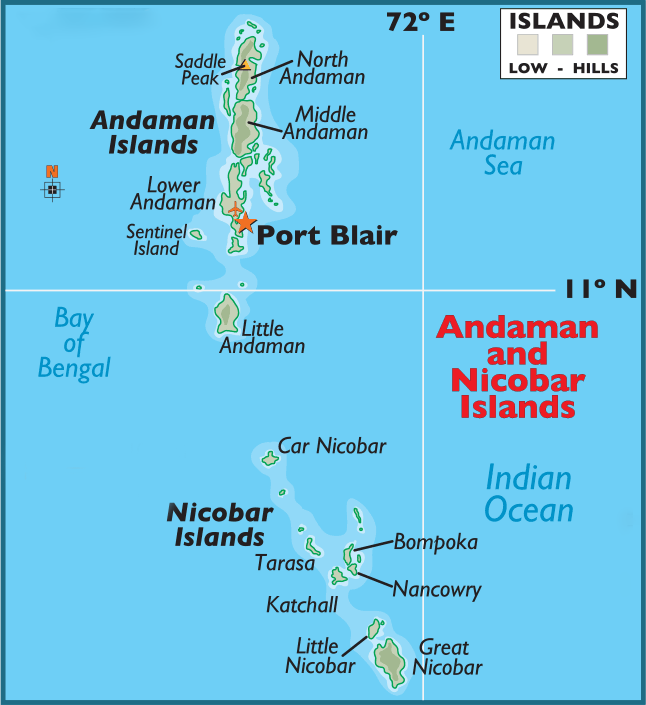-
23 Aug 2023
GS Paper 1
Geography
Day 33: Considering the susceptibility of Andaman and Nicobar Island, how has the potential impact of the recently proposed development project on Great Nicobar's vulnerability been assessed? (150 words)
- Introduce the susceptibility observed on the island of Great Nicobar.
- Discuss the possible impact of proposed development on Great Nicobar ecology.
- What measures could be taken to make the project ecologically viable.
- Conclude accordingly.
Answer:
Recently, the Ministry of Environment, Forests and Climate Change (MoEFCC) has granted environmental clearance for diversion of 130.75 sq. km of forest in Great Nicobar Island (GNI) for mega ₹72,000-crore multi-development projects.
- Situated in the Bay of Bengal, the islands are exposed to various natural hazards such as earthquakes, tsunamis, tropical cyclones, and sea-level rise due to their proximity to tectonic plate boundaries and the monsoon climate.
Possible impact of proposed development project:
- Impact on Biodiversity: The project has faced several criticism citing concerns regarding its adverse impact on the rich biodiversity of the area and damage to the habitats of endangered species.
- The project area is part of Coastal Regulation Zones-IA and IB, and the Galathea bay which is a nesting ground for birds.
- Also, turtle nesting sites, dolphins and other species will be harmed by dredging.
- Environmental and ecological concerns like impact on endangered species, coral reefs, mangroves etc.
- As per Niti Aayog the project requires to divert 130 sq km (about half the area of Athens, Georgia) of forest land and cut 8.5 lakh trees.
- Ecologically rich island was declared a biosphere reserve in 1989 and included in UNESCO’s Man and Biosphere Programme in 2013.
- Could disturb livelihood and culture of tribals, also compromising their forest rights under the Forest Rights Act 2006.
- 90% of the island is designated as a tribal reserve under the Andaman and Nicobar Protection of Aboriginal Tribes Regulation, 1956.
- Vulnerability to disasters like earthquakes, land subsidence etc., region comes under the high-risk seismic zone V category.
- Clearance Issue:
- The National Green Tribunal has ordered a stay on the ICTT and formed a committee to re-examine the environmental clearance granted.
- The local Tribal council withdrew NOC for the project as it fears that their rights will be violated.
- The National Commission for Scheduled Tribes (NCST) alleged discrepancies in forest clearance under Forest Rights Act (FRA), 2006 on grounds that the project will affect the rights of local tribes’ people and that NCST was not consulted.
Significance of the Project:
- The project has multiple purposes like: Defense, strategic importance, national security, and public benefit.
- Growing assertiveness from China in the Bay of Bengal and the broader Indo-Pacific region has made this project even more urgent recently.
- Great Nicobar Island holds significant economic and strategic value:
- While it has tourism potential, the government also aims to capitalize on its advantageous location for both economic and strategic gains.
- Situated between Colombo, Port Klang, and Singapore, the island lies along a crucial East-West international shipping route, utilized by a significant portion of global shipping trade.
- The proposed International Container Transshipment Terminal (ICTT) could transform the island into a central point for cargo ships navigating this route.
- The NITI Aayog has said in a report that the proposed port will allow Great Nicobar to participate in the regional and global maritime economy by becoming a major player in cargo transshipment.
Measures to make the project ecologically viable:
- Comprehensive Environmental Impact Assessment (EIA): Conduct a thorough and updated EIA to assess the potential ecological impacts of the project.
- Alternative Site Assessment: Evaluate alternative sites for the project that might have lesser ecological impact.
- Sustainable Infrastructure Design: Ensure that infrastructure is designed to withstand natural hazards like cyclones and earthquakes, minimizing risks of damage and disruption.
- Incorporation of Indigenous Knowledge: Consult and involve indigenous communities in the decision-making process.
- Forest Offsetting: Implement biodiversity offsetting measures, where any loss of biodiversity due to the project is compensated through conservation efforts in other areas.
The NGT's order to stay the Great Nicobar Island project and constitute a committee to review the environmental clearance aims to ensure that the project is compliant with the Island Coastal Regulation Zone 2019 and tribal rights.





